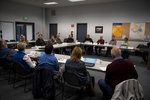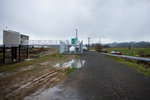




Changes were afoot during Thursday’s Chehalis Basin Flood Authority meeting held at the Riverside Fire Authority headquarters in Centralia.
Perhaps most significantly, the group voted to alter the meeting schedule so that in-person meetings will be held just once every two months. Currently, the Flood Authority meets once per month, although some of those meetings are conducted via conference calls.
During February’s Flood Authority meeting, a discussion took place on the merits of reducing the scheduled meeting to just four times per year in order to ease the travel and time burdens on participants. Members noted that quarterly meetings are equal to the bare minimum allowed according to guidelines. On Thursday, a contingent of group representatives spoke up to express their concern that quarterly meetings would be too infrequent to accomplish projects of consequence, and some complained that conference calls have proven ineffective.
Alan Vanell, the Flood Authority representative from Bucoda, was the first member to object to the quarterly meeting proposal, noting that the group needs additional opportunities to set up their numerous and intricate projects. He noted that under a quarterly system members could easily go six months without interacting with one another.
Dan Wood, the Flood Authority representative from Montesano, agreed with Vanell. He made sure to extol the virtues of frequent meetings among the vast number of partners.
“There's a culture here that I don’t think we can sustain without meeting face to face regularly,” said Wood.
That culture that Wood spoke of was not always a reality for the Chehalis Basin Flood Authority. In the early part of the decade, members spent much of their time quarreling with each other over perceived slights. At one point, the infighting and lack of progress became so egregious that the Legislature threatened to pull funding, and several entities threatened to break off from the group to create their own splinter cell workgroup.
That’s when Jim Kramer of the William D. Ruckelshaus Center was brought in to calm the waters as facilitator of the group. Over the last six years, Kramer introduced concepts such as taking turns when talking, compiling detailed meeting agendas ahead of time and respecting other people’s points of view.
On Thursday, Kramer announced his resignation from the facilitator position, stating that he felt he had fulfilled his objective and that funds could be now be better spent on “more important work.” The ensuing round of applause and compliments that flowed forth from the rest of the Flood Authority members was a fitting example of the sort of culture that Kramer helped foster during his tenure.
“We are in a funny business in that when things are finally working well and running smooth, then we are no longer needed,” said Kramer. “You’ve gone from the newspaper reporting what you called each other at a meeting to stories that are essentially updates on the progress that you’ve been making.”
Kramer noted that he would remain involved with the Flood Authority in his role as overseer of the entire Chehalis Basin strategy effort.
“I would really advocate that you don’t see your mission as just local projects, even though that is important, but also as advocates for your local communities to the Office of the Chehalis, and then as advocates for the Office of the Chehalis to your local communities,” added Kramer as a bit of parting advice.
Thursday’s meeting did include time to discuss the progress of local projects. The biggest update was related to the North Shore Levee project in Aberdeen and Hoquiam. That project, which will reduce flooding impacts and insurance rates in the harbor, recently received $2.5 million of funding in the state capital budget.
“We are very thankful,” said Hoquiam City Administrator Brian Shay.
In Montesano, the most pressing need is to fix the municipal wastewater treatment plant that is currently sitting halfway in the Wynoochee River due to stream migration. As it stands currently, the plant is at risk of completely failing and falling in the river, releasing its unmentionable contents directly into the Lower Chehalis River system. Dan Wood said the city is working on putting up river jacks to support the structure and attempting to gain approval to open a nearby side channel that is currently cut off due to manmade impediments. Wood thanked the Flood Authority for providing funds for the project and expressed his hope that the plant will not fail and provide “a gift” to all of the communities downstream.
In the Twin Cities of Lewis County, the discussion centered around the recent completion of a new pump station at the Chehalis-Centralia Airport. The old pump station was a relic from the mid-20th century that had fallen into disrepair and was prone to failure. Several members of the Flood Authority joked that the old pumphouse resembled a ramshackle outhouse.
The new pumphouse, conversely, is bordering on being overbuilt. The structure is elevated above most worst case scenario flood levels and contains two high-powered pumps that are fired up monthly for inspection. Currently, the pumps are set to turn on automatically when the river reaches 10 feet. During a flood event, those pumps, situated at the north end of the airport property, would send water from behind the levy, northwest through a hay field and back into the main river channel.
“It would take a major disaster for that not to work now with the way that it’s been designed,” said Trent Lougheed, the Flood Authority representative from Chehalis.
J. Vander Stoep explained that the old pump station was designed by the U.S. military during World War II when they built the airport for landing large airplanes planes during the war.
“That’s why the airport is bigger than what a community of this size would otherwise need,” said Vander Stoep, who expressed frustration that the levy and commercial area of north Chehalis are often blamed for increasing flooding elsewhere in the basin.
“You can blame the war department for that levy being there because they are the ones who built it,” said Vander Stoep.
Looking ahead, the Flood Authority spent considerable time discussing their future plans for community outreach, particularly as it pertains to county fairs. In years past, the Flood Authority has staffed informational booths at the Thurston County Fair, the Southwest Washington Fair, and the Grays Harbor Fair. However, the group elected not to attend the Grays Harbor Fair last year, and some members wondered if tabling next to whack-a-mole games and cotton candy stands should be abandoned all together. Several members said that they typically are only able to engage with one or two people per hour, and staffing the booths has proven problematic time and time again.
“I think they’re valuable. They’re just hard to staff and hard to fill,” reasoned Scott Boettcher, Flood Authority staff from SBGH Partner. “Those personal interactions can really help to change people’s views.”
As a reminder about the urgency of these matters, one slide during the meeting pointed out that five of the worst Chehalis River floods on record since 1928 have occurred since 1986. That means that as the memory of the 2007 flood recedes, the reality of the next big flood creeps ever closer.
Lewis County Commissioner and Flood Authority member Edna Fund agreed with Boettcher that face-to-face interactions are important.
“I would say it’s more important now as we try to keep away ‘flood apathy’ or whatever you want to call it. It’s helpful to get our message out there,” said Fund.
Other members suggested shifting the focus away from county fairs, where distractions are sort of the point, and instead creating a “speakers bureau” to do targeted presentations. Venues for those Flood Authority presentations included farmers markets, the Grays Harbor Splash Festival and similar events where folks might be more inclined to stop and talk about hydrology.
One issue that homeowners in the floodplain are always eager to discuss is the rising tide of flood insurance. In most counties in the region, participation in flood insurance programs has decreased significantly in recent years. Opinions vary about the cause of the exodus from the National Flood Insurance Program, but the result has been increased costs for those who are still enrolled.
“A reason why a lot of those people have dropped their insurance have actually been removed from the floodmaps,” said Lougheed, who noted that more accurate floodplain data is gradually leading to improved flood mapping. “I don’t think I’ve processed one survey that didn’t need a revision since I’ve been in Lewis County. They need to spend a little more time to do a better job, especially for the prices they are charging.”
Flood Authority members from Aberdeen and Hoquiam noted that the North Shore Levee will allow some residents to be removed from mandatory participation in the flood insurance program. However, they argued that the current decrease in participation in Grays Harbor has more to do with a weak housing market. Banks require homeowners who are paying off mortgages within the floodplain to carry flood insurance, but that requirement goes away once a home is paid off. Harborites argued that out of town cash buyers are simply buying homes outright at “rock bottom prices” and then opting out of the flood insurance program while they turn the homes into rentals.
Boettcher noted that some insurance has been going up by as much as 18 percent per year. However, he said that homeowners can often influence the cost of their insurance by obtaining an elevation certificate that precisely details the risk to their property. He pointed out that a pilot project is currently underway in Centralia in order to find the price point where homeowners are incentivised to obtain elevation certificates and then make mitigation efforts such as filling basements prone to flood damage, or installing foundation flood vents.
Under the newly agreed upon meeting schedule, the next Chehalis Basin Flood Authority meeting will be held at 9 a.m. on May 19 in Hoquiam.